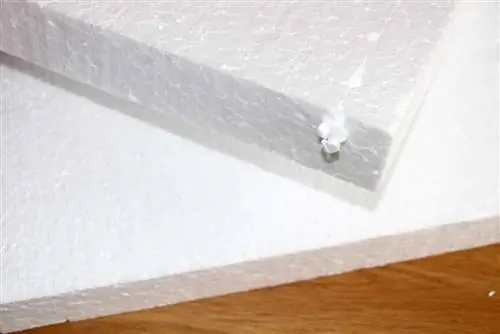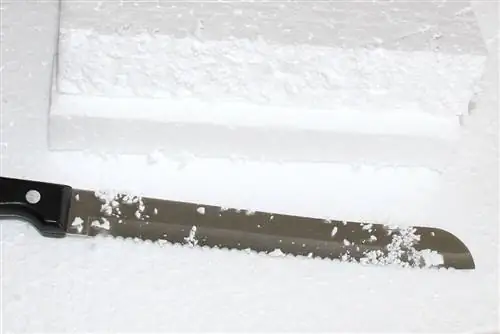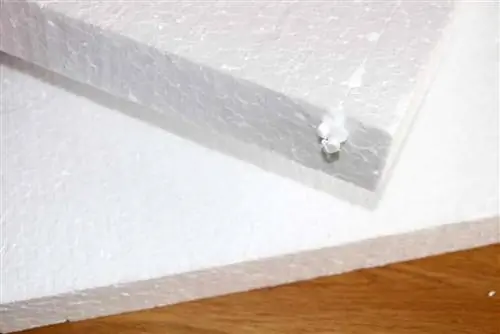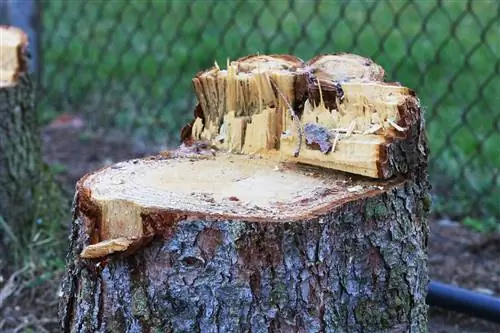- Author admin [email protected].
- Public 2023-12-17 03:39.
- Last modified 2025-06-01 06:48.
Styrofoam, also known as foam polystyrene, is used in various areas. It is a popular material as an insulation material, for craft work or for making decorations. Unfortunately, cutting it smoothly is difficult. When working with knives, too many of the caked-on foam balls can break out, creating dents or holes. With the right approach, this problem can be avoided.
Suitable cutting tools
Various cutting tools are suitable for cutting foam polystyrene to size. These include, among others:
Cutter or carpet knife
They have very sharp and narrow blades, which makes them comparatively well suited for cutting Styrofoam to size. However, they must be handled carefully and slowly to prevent the material from breaking and fraying.
Knife
Knives with very thin, sharp, straight cutting surfaces are relatively suitable for thinner Styrofoam plates. However, it should not be cut with the next best kitchen knife. The blade should at least be freshly sharpened beforehand.

Sawing
Saws, for example for fretwork, but also a foxtail can be used. However, with these there is a risk - especially in variants with rather large Styrofoam balls - that individual beads will break out. In addition, the material has to protrude a little over the base and is therefore less stabilized. This increases the risk of plates or other thinner shapes breaking completely.
Styrofoam cutter
If you cut Styrofoam frequently, you should invest in a so-called Styrofoam cutter. A distinction is made between hand-held devices and table-top devices. The blades or the cutting wire used are heated so that the cut surfaces are slightly fused and therefore very smooth.
Thermal saws and hot cutting machines
Thermal saws and hot cutting machines work on the same principle as the Styrofoam cutter. The blades are heated and glide through the material. This significantly reduces the risk of broken balls or broken sections.
For larger cutting surfaces, very precise shaping - such as in model making - or for more frequent use, the use of a polystyrene cutter is recommended. This cuts very smoothly and is particularly easy to use. Larger table-top devices can sometimes also be rented from hardware stores. This is cheaper than purchasing if the devices are only to be used once for a larger project.
Preparation
Before cutting the foam polystyrene, three preparatory steps should be done. These are:
Test cut
Whether Styrofoam plate or another shape, thick, thin, large or small balls, very dense material or rather loose foam polystyrene is to be cut - the differences in the material determine the cutting behavior. In order to enable precise work and to find the right cutting tool, a test cut should be carried out. It is therefore advisable to have a sample ready especially for this purpose and to test different cutting tools on it. You can also practically find out how much pressure is necessary for a clean cut.
Prepare the base
Especially with panels, there must be a stable and appropriately sized base. The material should not overlap to a large extent or “float freely in the air” during cutting, as this poses a risk of breaking. It must also be noted that the base is cut-resistant. Otherwise scratches and notches could quickly occur.
Measuring and drawing
In order to get clean cuts, the desired shape and the desired dimensions, these must be measured and sketched out. Of course, the principle applies here as always: measure twice, cut once. Therefore, especially with thicker panels, you should pay attention to the angle at which you need to cut and mark the line accordingly.
Cutting Styrofoam - step by step

As soon as all the preparations have been made and the ideal cutting tool has been found, the cutting can begin. The following steps and tips show how to do it:
- After measuring and marking the desired cutting line, the piece of Styrofoam is aligned on the base. Only a few centimeters should protrude above the surface on which you are cutting. Of course, there is an exception when a plate is cut from above with a knife. Then the plate should not protrude at all, but should rest completely on the base.
- Cut slowly and with little pressure along the pre-drawn cutting line. Even when holding the plate, you should not press too hard to avoid dents in the material.
- For larger pieces of Styrofoam or difficult cutting shapes, it is recommended to first make a rough cut - for example with a saw or a cutter. The cut edges do not have to be clean and completely smooth.
- The fine cut can then be carried out with a Styrofoam knife or another hot cutting device. This makes work easier and helps to achieve a precise result.
Tip:
Beads released when the Styrofoam is cut often spread throughout the area and adhere to many surfaces. Wiping or sweeping can quickly become a game of patience and requires a lot of unnecessary effort. It's easier to suck up the beads.






